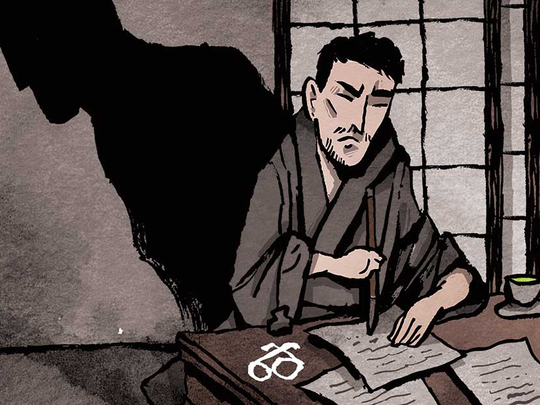
By Junichiro Tanizaki, Translated by Phyllis I. Lyons, Columbia University Press, 238 pages, $60
I want to be fair to the dead. Some readers think fiction writers garnish the truth with a sprig of parsley and pass it off as a story entree. I’ve heard it all. Fiction is roman a clef. A first novel is always autobiographical. The protagonist’s problem is a stand-in for the author’s neurosis. Of course, novelists routinely protest too much. Fiction writers make things up, and it can be difficult work, we claim, because these things must be summoned from somewhere beyond memory and history and then shaped into narrative. However, somewhere between the accusation and the defence, there’s the story, and sometimes a writer’s biography may need to be considered. When it comes to reading Junichiro Tanizaki’s 1928 novel In Black and White, translated beautifully by Phyllis I. Lyons, an emeritus professor of Japanese language and literature at Northwestern, it may help the reader to know that there was an actual death associated with Tanizaki’s literary murder story.
Tanizaki (1886-1965) is best known for his masterpiece, The Makioka Sisters (published serially between 1943 and 1948), and for his shorter novels Naomi, Quicksand, The Key and Diary of a Mad Old Man. Born into a Tokyo merchant family with declining fortunes, then later studying literature at Tokyo Imperial University until there was no money left for school fees, Tanizaki started off his professional life by writing plays, stories and screenplays, often involving his erotic and diabolist obsessions. He cultivated his lifelong interest in traditional Japanese literature and Western literature and was deeply concerned with aesthetics, as displayed in his essay collection, In Praise of Shadows. Nearly all his works remain in print today. However, In Black and White, first serialised in 1928, was never published as a single volume in Japan. Now Lyons has rescued this work from obscurity, nimbly arguing in her afterword that it defines a “pivotal moment” in Tanizaki’s literary development.
In terms of genre, In Black and White is a comic novel satirising the Japanese confessional narrative, which has identifiable resemblance to the author’s life; it functions as a framed story, or a story-within-a-story, nesting the fates of two writers. At the outset, a magazine called The People commissions the protagonist, Mizuno, to write a mystery.
Mizuno intends to describe a perfect crime, one in which the killer can’t be caught. In this story, To the Point of Murder, the victim is a writer named Codama whom Mizuno bases on a writer of his acquaintance named Cojima. The difficulty begins when Mizuno carelessly includes the model’s name, Cojima, towards the end of the manuscript and the story goes to press uncorrected. Paranoid, Mizuno believes that the literary world will recognise the real Cojima as the model for Codama, then leaps very far to the delusional conclusion that if the real Cojima were to be killed, Mizuno himself would be blamed. (A little Tanizaki humour: For a writer, the lack of a copy editor may lead to murder charges.)
A magical thinker of the first order, Mizuno decides to write himself out of real criminal guilt by producing a fictional sequel, “To the Point of the Murder of the Man Who Wrote ‘To the Point of Murder,’” which features a so-called Shadow Man. The reader can’t know if the Shadow Man is real because he never makes an appearance, but it is he who has orchestrated the death of Codama so the unnamed author in the mystery story can be framed for murder, tortured and forced to confess, then be executed. By the end of the fictional sequel, the Shadow Man murders the fictional Codama and the state executes the fictional author. However, the reader will discover that the author is innocent because the diabolical Shadow Man has engineered the execution of both writers.
Mizuno is a morally suspect, slothful and self-centred man, yet he’s sufficiently talented that his social misdemeanors — rent arrears, missed deadlines, personal debts, lies, cruelty to others — are tolerated. Here, as elsewhere in Tanizaki’s oeuvre, there are recognisable sexual obsessions and female types.
Mizuno has an ex-wife who left him because he wrote too many wife-murder stories; she ends up marrying a Methodist minister and converting to Christianity. Then Mizuno falls under the spell of Fraulein, a heartless Japanese prostitute who speaks German and eats black bread and sausages. The innocent and dull wife stands in sharp contrast to Mizuno’s “contract mistress,” who has “the look of a Western streetwalker.” Mizuno gives Fraulein the yen he has taken dishonestly from his publisher so she can “pretend and make it seem to me like real love.”
In Black and White is highly plotted and self-consciously clever. Nevertheless, the reader is left wanting because the story lacks the pathos and bathos that great comic fiction requires. At times, this slim novel can drag, something a serial writer must take great care to prevent. That said, Tanizaki does raise important aesthetic questions about what fiction writers do and why.
Under duress, Mizuno confesses to a detective: “In actual daily life when I’m dealing with people, I do tell lies all the time. But when I take up my pen and work creatively, I expose myself bravely and frankly even if it goes badly for me. In that respect, I believe I am more honest than most of what the world calls ‘good men.’ That is my way of working to be a man you can believe. And that’s where I take my pride as an artist.” Here Tanizaki allows the immature Mizuno his shred of integrity.
Nevertheless, the murder mystery doesn’t make sense because there’s nothing in the plot that offers a rationale for the important question of motivation behind the most serious action a novelist can take — the death of a character. Why does Mizuno want the fictional Codama to die? Why does the Shadow Man want Mizuno to be guilty of a crime he didn’t commit and be executed? Why does Tanizaki want his central character to die?
Well, there is that actual death. In 1927, a year before In Black and White was written and published, Tanizaki engaged in a famous literary spat with the writer Ryunosuke Akutagawa, remembered now for having written the stories that formed the basis of Akira Kurosawa’s classic film Rashomon.
To put the aesthetic fight in crude terms, Tanizaki argued that plot mattered and Akutagawa disagreed. The spat went on for months in the pages of the literary magazine Kaizo, and ended only when Akutagawa, age 35, killed himself by taking an overdose of barbiturates on Tanizaki’s birthday, July 24. The literary world was set aflutter with recriminations and vicious gossip. Within a year, Tanizaki had started In Black and White. Although an English translation of the Japanese title, Kokubyaku, means “black and white,” the word is also a homonym for kokuhaku, meaning “confession.”
–New York Times News Service
Min Jin Lee’s most recent novel is Pachinko.









